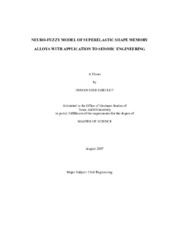| dc.description.abstract | Shape memory alloys (SMAs) have recently attracted much attention as a smart
material that can be used in passive protection systems such as energy dissipating
devices and base isolation systems. For the purpose of investigating the potential use of
SMAs in seismic engineering applications a soft computing approach, namely a neurofuzzy
technique is used to model dynamic behavior of CuAlBe shape memory alloy
wires. Experimental data are collected from two test programs that have been performed
at the University of Chile. First, in order to evaluate the effect of temperature changes
on the behavior of superelastic SMA wires, a large number of cyclic, sinusoidal, tensile
tests are conducted at various temperatures. Second, to assess dynamic effects of the
material, a series of laboratory experiments are conducted on a scale model of a three
story model of a building that is stiffened with SMA wires and given excitation by a
shake table.
Two fuzzy inference systems (FISes) that can predict hysteretic behavior of
CuAlBe wire have been created using these experimental data. Both fuzzy models
employ a total of three input variables (strain, strain-rate, and temperature or prestress)
and one output variable (predicted stress). Values of the initially assigned membership
functions for each input are adjusted using a neural-fuzzy procedure to accurately predict
the correct stress level in the wires. Results of the trained FISes are validated using test
results from experimental records that had not been previously used in the training
procedure. Finally, numerical simulations are conducted to illustrate practical use of these
wires in a civil engineering application. In particular, dynamic analysis of a single story
frame and a three story benchmark building that are equipped with SMA damping
elements are conducted. Then, an isolated bridge that utilizes a linear rubber bearing
together with SMA elements is analyzed. Next, in order to show recentering ability of
SMAs, nonlinear time history analysis of a chevron like braced frame is implemented.
The results reveal the applicability for structural vibration control of CuAlBe wire whose
highly nonlinear behavior is modeled by a simple, accurate, and computational efficient
FIS. | en |


